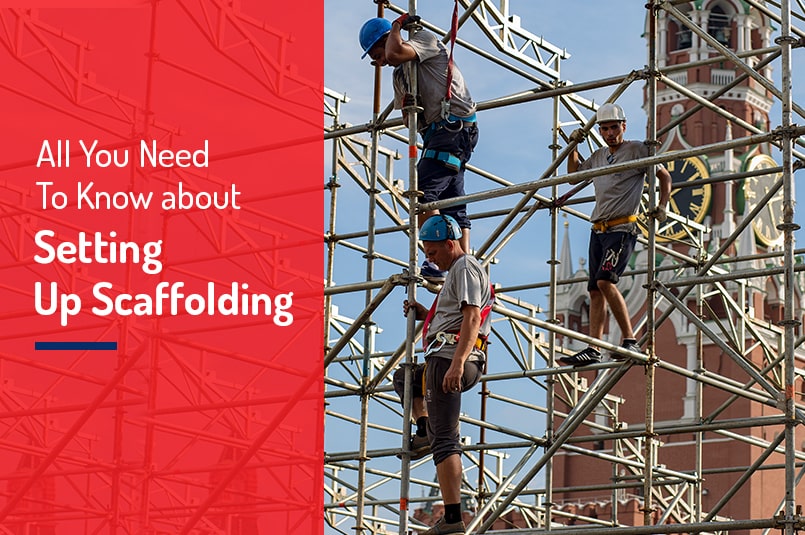
Scaffolding– The temporary structure of buildings, monuments, bridges, and all man-made structures has always aided humankind. Over 17,000 years ago, the first use of scaffolds to paint the ceiling was coined. From antiquity to the modern era, scaffolding is the system that has boosted civilization, transportation, and all developments of human necessities.
Scaffolding, being a puzzle in nature, requires a set of instructions to hold a strong structure. This involves having precise planning and layout of the structure & finally erecting the same. Besides this, knowing the requirements and following safety measures on site is also important. It becomes essential to note every point in-and-out when you buy scaffold online.
Hence, to streamline the needs and deeds for scaffolding, below are some basic points to be noted.
- Prerequisites for scaffolding
- Planning
A detailed understanding of the following points is essential while planning to work on a new construction site:
- Location of the site
- Period of time the scaffold is to be used
- The purpose of scaffolding (construction, painting, renovation, etc.)
- Dimensions of the site that may affect the choice of scaffold
- Specific provisions like- a pedestrian walkway, restricted area, the inclusion of a mechanical handling plant, etc.
- The specifics of ground condition
- The type of scaffold required based on climatic conditions
- Inspection of maximum bay length, lift heights, load class, leg loads, and tie duty
- Preparation of Site & Organization of Scaffolding Accessories and Parts
After considering site requirements, the next step is to note the following points, and arrange scaffoldings accordingly;
- Number or loading lifts required
- Type of access needed on the scaffold
- Type of scaffold required (ringlock scaffolding system, tube lock scaffold system, etc.)
- Additional requirements for beamed bridges, loading bays, etc. (standard or customized designs)
- Leveling the ground if required
- Knowing Safety Measures
Along with planning and buying/ arranging the scaffold, the safety measures are to be considered.
- Workload capacity of using a particular scaffold structure
- Assembling & Disassembling the scaffolding according to guidance provided by NASC in document SG4 ‘Preventing falls in scaffolding’, or similar guide provided by manufacturers of scaffold system
- Using OSHA guidelines for safety and precautions at construction site
- While using ladders & tower scaffolds, ensuring stability and get regular inspection
- Avoiding the work on fragile surfaces or working under proper control & co-operation
- Scaffold should meet electrical safety clearance distances
- Registering reference number, date, etc. to enable recording, referencing, and checking
- Erecting Scaffolding
Before erecting the scaffoldings, ensure that,
- You have a valid work permit
- You have barricaded the work area
- You have put a warning sign
- You have a proper risk assessment/ TBT
- You have selected scaffoldings from the single manufacturer
- You have a proper layout of scaffolding structure
Once you are done with the aforementioned, you are ready to build a strong scaffold structure. Building a scaffold requires a trained work crew, which will ensure seamless work. Below mentioned are the steps for erecting the scaffold:
- Build a foundation using base plates or mud sills to make footing more stable. The foundation must be secured on the ground. If there is unlevel ground, then consider using adjustable screws on the scaffolding to level the structure.
- Include casters in your scaffolding system if you intend to move it & operate at different locations. Once you get it in position, don’t forget to lock the casters.
- Assemble the scaffolding frames by lifting one end piece and attaching the upper cross brace. Then lift the second-end piece and fasten its upper cross brace. Attach the bottom of the opposing end frame to the ends of the cross braces.
- Shift the scaffold to the desired location and make sure that the system is stable.
- Place the planks at desired workstations and fasten them in one place. Choose the highest quality planks that ensure maximum workload from the best wooden or aluminum scaffold plank manufacturers.
- Secure access to the scaffold with a ladder. Fasten the ladder and make sure they are stable.
- When working at platforms at a height, attach the guardrails to the scaffolding system. Use tie-offs and other fall protection measures.
- After building scaffolding, ensure all the joints are secured & reinspect them each day before work.
- Post-Scaffolding Measures
Once the scaffolding is erected,
- Make sure that you don’t overload it
- Avoid throwing scaffold materials on the ground
- Clean left-overs & tools every day after work
- Have housekeeping for all unused scaffolding accessories
- Regulate the testing of scaffolding until the day it is in use
Final Word
Regulation and maintenance of all the above points is essential while building a safe scaffolding system. At Scaffolds Supply- the leading ringlock scaffolding system, Tube & Clamp scaffolding system, and cuplock scaffolding system manufacturers in the USA, provide you top-notch certified scaffolding accessories & parts. All our scaffoldings come with a proper user manual considering safety measures.
We hope that the article was informative. You can connect with us at scaffoldssupply.com











Comments are closed